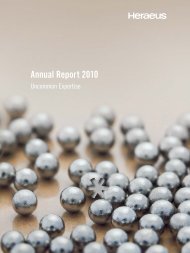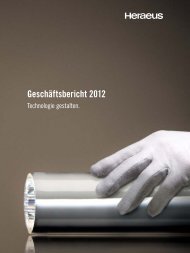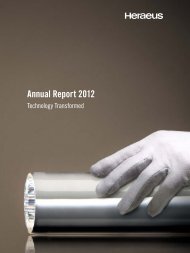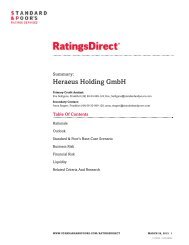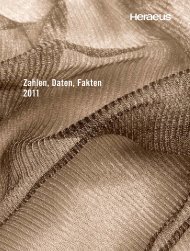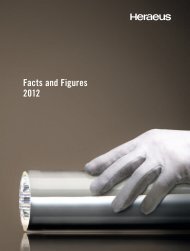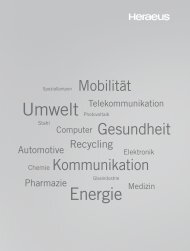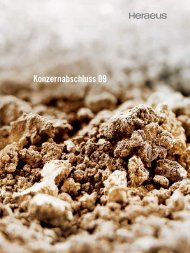English
English
English
You also want an ePaper? Increase the reach of your titles
YUMPU automatically turns print PDFs into web optimized ePapers that Google loves.
The characteristics of high-performance quartz glass have to be perfect.<br />
Quality checks are performed with the very latest measuring systems.<br />
infrared spectrum,” reports Dr. Mark Altwein, Business<br />
Unit Manager at Heraeus Quarzglas.<br />
“Suprasil ® 3001 is optically isotropic, highly homogenous<br />
and suited primarily for manufacturing multidimensional<br />
optics such as prisms, extremely curved lenses, beam<br />
splitters, beam controlling systems and retro reflectors,”<br />
states Altwein, a physicist. For these reasons, this type of<br />
quartz glass is best suited for high-energy lasers that operate<br />
in the near infrared range. Diode lasers use it in the<br />
field of medical technology for processing materials and<br />
spectroscopic optics.<br />
The material is currently being used in a unique and special<br />
project involving experiments with gravitational wave<br />
detectors to research another aspect of Einstein’s theory<br />
of relativity. Gravitational waves are emitted by distant<br />
astrophysical events such as supernova explosions, neutron<br />
stars and black holes. Gravitational wave detectors,<br />
which measure the corresponding gravitational waves deep<br />
underground, utilize highly sensitive optical interferometers<br />
that can reach a length of 4 km. They function as a<br />
photon reservoir and contain quartz glass with extremely<br />
high transmission values and optical homogeneity. And the<br />
instruments’ optical components that are so essential for<br />
taking these measurements are made of Suprasil ® 3001<br />
technology report 02<br />
“The capabilities and<br />
capacities of quartz glass<br />
are far from exhausted!”<br />
by Heraeus. “We have been so successful in improving the<br />
absorption in our quartz glass that we’ve made a significant<br />
contribution to improving the instrument’s sensitivity.<br />
With all the improvements, the gravitational wave detector<br />
has become extremely sensitive. Instead of measuring<br />
one event per year, it now measures one event per week,”<br />
according to Ralf Takke.<br />
Considering its fascinating nature, it is astonishing that so<br />
few universities and research institutes work intensively<br />
with the properties and applications for quartz glass. For<br />
that reason, most expertise is generated in the private industry<br />
sector. Heraeus has been able to contribute a great<br />
deal to quartz glass knowledge over the last 110 years.<br />
Dr. Ralf Takke is convinced: “We are certainly approaching<br />
perfection in some applications such as microlithography.<br />
But the capabilities and capacities of quartz glass are far<br />
from exhausted!” Dr. Jörg Wetterau<br />
Want to know more?<br />
Dr. Ralf Takke<br />
Division Optics<br />
Heraeus Quarzglas GmbH & Co. KG<br />
Quarzstr. 8, 63450 Hanau<br />
Phone: +49(0)6181.35-6332<br />
E-mail: ralf.takke@heraeus.com<br />
Internet: www.optics.heraeus-quarzglas.com<br />
RESEARCH & DEvELOPMENT<br />
41






